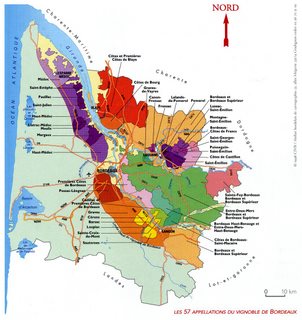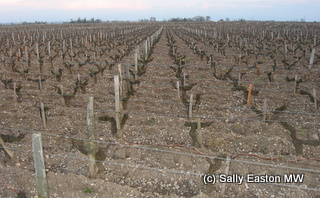Bordeaux basics
A version of this article first appeared in Fine Expressions magazine during 2005, updated 2009.

Bordeaux wine region
Bordeaux is the most prestigious and the finest wine producing area in the world. The eponymous region in south west France is the home of some of the most sought-after “collectors’ items” in the world, as well much good value everyday wine. It produces 14% of all French wines, 65-70 million cases, which is more than Romania.
HISTORY
The region is one of the oldest wine growing regions, and there is a long trading history with England. A 12th century royal marriage gave to England much territory in south west France, and favourable trading terms.
During the 17th and 18th centuries, long after the land reverted to French ownership, entrepreneurs from several countries such as Ireland, Britain, the Netherlands and Germany moved to Bordeaux to trade and export wine to their home countries.
It was the Dutch, with their excellent land-drainage skills who, by draining the marshy land of the Médoc in the mid 17th century, exposed their beautifully draining gravels, laying the foundation for the modern Bordeaux wine region – the left bank – and its top quality wines.
Bordeaux reds are often called claret in the UK as a linguistic artefact of our centuries-long historical trading association.
GEOGRAPHY AND CLIMATE
The Bordeaux region covers over 120,000 hectares (300,000 acres). The climate is similar, but a bit warmer to southern England: temperate, with mild winters, damp springs and rainy autumns.
The region is sliced into three big chunks by the Gironde estuary, which is fed by the rivers Dordogne and Garonne. The Entre-deux-mers is akin to the bread-basket of Bordeaux producing much everyday red and white wine. But it is the left bank of the Médoc that lays claim to the finest red wines of Margaux, St. Estephe, St Julien and Pauillac, and the right bank to the highly-prized reds of Pomerol and St. Emilion.
The best dry whites come from the Graves, immediately south of the city of Bordeaux, and the most famous sweet whites just south of that, in Sauternes and Barsac.
Bordeaux has a total of 57 appellations — a specific, delimited area of land, the name of which appears on the label. These appellations generally avoid land that is of too poor quality to grow grapes such as low-lying badly drained land, or soils that are too sandy.
To qualify for an appellation all the grapes must be grown within the borders of the appellation. So, for a wine labelled ‘Bordeaux Appellation Contrôlée’ the grapes can come from anywhere within the 120,000 hectares. But there are fewer than 800 ha of vines in Pomerol, which makes average production per grower a tiny 2,500 to 3,000 cases. As a point of comparison, in the UK, we buy over 2.5 million cases of Aussie wine Jacob’s Creek to drink at home.
Another criterion for appellation is the use of specific grape varieties. For Bordeaux, all red wines are made from cabernet sauvignon, merlot and cabernet franc (sometimes with sprinklings of petit verdot and malbec). All white wines, both sweet and dry, are made from differing proportions of sauvignon blanc and semillon, sometimes with a little muscadelle. Bordeaux wines cannot be made from any other grape varieties. As a comparison, the appellations of Burgundy must be just pinot noir for reds and chardonnay for whites.
GRAPES AND BLENDS – RED

Pauillac vineyards
It is the red wines of Bordeaux that have claimed their place in wine immortality. They account for the lion’s share of production, about 90%. Over the centuries the Bordelais have found that blending their grape varieties can add additional layers of complexity and palate profile to a wine, with the best aspects of one grape variety complementing the best aspects of another. For the classic cabernet sauvignon/merlot blend the deeply coloured, tannic and richly blackcurrant-fruited cabernet sauvignon can be softened and rounded a little by the more supple tannins of merlot and its additional flavours added of earth, plum and warm bread.
Within this classic blend there is a useful distinction to be found between the left bank and right bank. The Médoc tends to have a higher proportion of cabernet sauvignon in the blend, maybe 60-70%, which lends a stronger, more structured profile, with more tannic grip. The remainder will be 20-35% merlot, up to 15% cabernet franc, plus a little “seasoning” from those other two grape varieties.
Right bank wines tend to have a higher proportion of merlot (~60%) and cabernet franc (~30%) which offer a softer, rounder, more approachable and supple profile, supported by the strength of about 10% cabernet sauvignon. Right bank wines are often considered an easier introduction to people unfamiliar with the wines of Bordeaux. And in terms of value, some of the best reds are to be found in the lesser known right bank appellations such as Bourg, Blaye, Fronsac and Côtes de Castillon.
GRAPES AND BLENDS – WHITE
White Bordeaux wines are made from semillon and sauvignon blanc, and the sweet styles may have a little muscadelle also. For dry whites at the lower end of the market – likely from the Entre-deux-Mers – the best may be varietal sauvignon blanc, unoaked, aiming at primary fruit expression, an aperitif style. At the top end dry whites are generally blends and are serious, overtly oaked, creamily-textured wines needing appropriate food pairing to show their best colours. The emphasis for this style is on structure and potential longevity rather than immediate fruity appeal and the price reflects this, often £20 and more.
The sweet white wines of Sauternes and other appellations such as Barsac, Saint-Croix-du-Mont and Cadillac are made in a very different way. Some grapes are left on the vine after the ‘dry wine’ harvest. As autumn approaches and with it the risk of rain, the mornings in places close to the river may be misty which brings a beneficial mould, botrytis. Botrytis wraps itself around each intact berry, drawing water from it, thereby concentrating all the other grape constituents. So long as the afternoons are dry all is well, but if the autumn is damp and rainy the mould can turn nasty and cause the remaining crop to rot, by splitting the berry skin and exposing the pulp. Semillon has thin skins which are susceptible to this magical, risk-laden botrytis. Blending with sauvignon blanc, which has naturally high acidity, balances the final wine.
CLASSIFICATION
Almost unique to the wine-producing world, a few Bordeaux properties are classified. About 200 properties are classified, among the ten thousand growers, and it is these ‘top’ châteaux that provide the global benchmark.
The 1855 Médoc classification is the most widely known (see it here). It was drawn up for the Universal Exposition in Paris of the same year. Market prices of the day formed the basis of a list of producers whose wines consistently attained the highest prices. This group of 60-odd châteaux were ranked into 5 groups – first growth through to fifth growth – what are now known as the ‘classed growths’.
Other properties, such as those in the Graves, Sauternes and St. Emilion, have also been classified, bringing the total up to 200.
REPUTATION AND QUALITY
At their best and classic expression, the prestigious appellations (containing those classified properties) of St. Estèphe, Pauillac, St. Julien, Margaux, Graves, Pomerol, St. Emilion show subtly different flavour profiles, which reflect the particular site where the grapes have grown. This is the essence of ‘terroir’ or the ‘sense of place’ that good quality wines display.
The vast majority of wine is produced in the less prestigious appellations – the Entre-Deux-Mers and areas lying outside the key names. Some of these wines are bottled at the property and sold as “petit châteaux” wine under its specific appellation and Château name. Much is sold in bulk to merchant firms which blend various wines into brands e.g. Mouton Cadet, Numéro 1, Sirius, Calvet Classic, sold under the most generic appellation of Bordeaux Appellation Contrôlée. The advantage here is that the merchants are able buy fruit and wine from all the Bordeaux vineyards with the aim of finding the best quality they can to fit into the price of their brands. This is a vital part of the Bordeaux market, and a way of potentially offering consistent and reliable wine styles for consumers to try the region’s wines.



